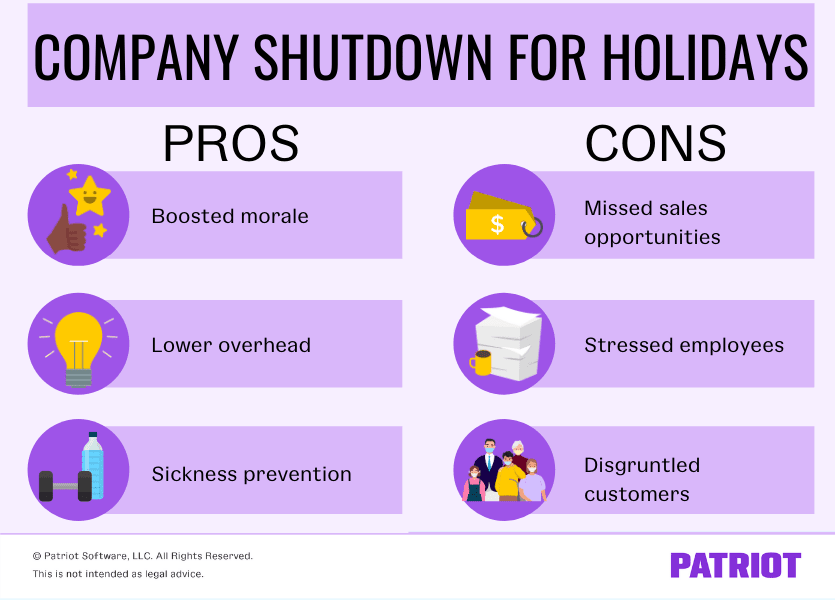What does a holiday company shutdown have to do with lower overhead and COVID-19? Turns out, a lot. Major corporations like Best Buy, Target, and Walmart have already announced store closures for Thanksgiving 2020 due to the pandemic.
Find out what exactly is a holiday shutdown, weigh the pros and cons, and—if interested—learn how to do it.
What is a holiday shutdown?
A holiday shutdown is when a business closes up shop due to a holiday. The closure could be for a few days, a week, two weeks, a month … you get the picture. During this time, the business’s operations cease and employees do not perform work. Generally, employees are briefly furloughed.
Temporary business closures during the holidays are most popular during the month of December (e.g., Christmas shutdown). But, you can do a shutdown anytime there is a federal legal holiday or other holiday.
Here are just a few examples of when you might close down your small business:
- Partial week shutdown for Thanksgiving
- Week-long closure during the Fourth of July
- Two-week shutdown for Christmas and New Year’s
Typically, a business shutdown is mandatory unpaid time off employees must take. Depending on your business’s policy, employees may be able to use their paid time off (PTO) during the shutdown.
You might be wondering: what exactly is the point of a holiday closure? In addition to giving you and your employees time away from work, you could save money on overhead. During a shutdown, you aren’t using power, which cuts down on your electricity, water, and gas usage. But, we’ll go into that more when we weigh the pros and cons…
Pros and cons of a company shutdown: Holiday edition
A company-wide shutdown for the holidays may not work for all businesses. Consider the advantages and disadvantages before closing up shop.

Pros
There are a number of reasons why businesses shut down during the holidays, such as to:
- Boost morale
- Lower overhead
- Prevent sickness
Even if you’re a workhorse (which describes nearly all small business owners), you likely know the importance of recharging. By taking a mandatory break from work, you can boost your and your employees’ morale. And if you’re worried about making up for lost time, consider the idea that happy workers = better engagement and productivity.
By pausing operations for a week, you can cut out overhead expenses, which could help balance out the lost revenue. And if you notice less sales during the holidays, the shutdown could be a win-win for your business. Why spend on overhead when customers aren’t coming in?
Last but not least, shutting down your business around the holidays—particularly in the winter—could help slow the spread of sickness. This advantage couldn’t be more appealing to small business owners than during the era of COVID-19.
Cons
Of course, there’s a flip side to every coin. Before jumping into a holiday shutdown, consider the disadvantages, like:
- Missed sales opportunities
- Stressed employees
- Disgruntled customers
Do the holidays line up with your business’s busy season? If so, a company shutdown might not be the right move for you. Let’s say the month of December brings in 20% of your annual revenue. If you close your business down for two weeks during this month, you could be missing out on 10% of your annual revenue.
You might also want to consider the stress a temporary shutdown could put on your employees. If you aren’t paying employees during this period, they might struggle to make ends meet. And, your team could be stressed trying to get everything done before and after the shutdown.
Last but not least, think about your customers. If this is a popular time for them to frequent your business, you could have disgruntled customers. And if you fail to get the word out to them, you may have customers driving out to your storefront only to find the doors locked and the lights off.
How to do a company shutdown this holiday season
Want to turn up the cheer and do a company shutdown this year? Check out the following steps to get a feel for the process.
1. Research your responsibilities
If you shut your business down, you’re generally not obligated to pay employees for time they don’t work. However, things might be a little different if you do a partial-week shutdown and have exempt employees.
You do not need to pay nonexempt employees for time they do not work, according to the Department of Labor. But if exempt employees work any part of a workweek, you must pay them their regular weekly salary.
Consult the Department of Labor for more information, and do some state-by-state research to stay compliant.
2. Send employees a holiday shutdown notice
Give employees plenty of time to prepare if you require them to take time off. Distribute a digital or paper holiday shutdown notice.
Your notice should detail critical information like:
- The time period your business will be closed
- When employees can return to work
- If the time will be paid or unpaid
- Whether employees can use any PTO during this time (if unpaid)
3. Let your customers know
Before shutting your doors for the holidays, make sure your customers know. Like with employees, tell customers well in advance to avoid any surprises.
Meet customers where they are. Announce your company shutdown (along with the time period) on every channel you can. Consider letting customers know through:
- Social media
- Business website
- Storefront / throughout the store
Chances are, you won’t catch everybody. So, as a safety net, set a new business voicemail with the days and times of the closure. And, create an automatic email response letting people know your business is temporarily closed.
4. Adjust your business budget
If you’re planning on closing your business, you won’t be making sales. And, your expenses might decrease. Adjust your business budget to reflect the closure.
5. Wrap things up and close things down
And, last but not least, you have to go through the actual process of closing things down for the partial or full week (or weeks). To help you stay organized, make a checklist of all the things you need to turn off, lock, and secure.
Here’s a sample wrap-up checklist:
- Unplug equipment
- Set new voicemail message
- Deadbolt door
- Turn security system on
- Pay vendors
- Update your accounting books
- Run payroll
- Deposit money from your cash drawer into a bank account
Can’t shut it down? Consider these alternatives
If you aren’t too keen on the idea of closing your business’s doors for an extended period of time, you have options.
Instead of a full-on holiday shutdown, you can:
- Limit business hours (e.g., 8 a.m. – 1 p.m. rather than 8 a.m. – 5 p.m.)
- Offer employees holiday pay (e.g., double-time pay for hours worked)
- Accept time-off requests fairly
If you do adjust business hours during the holidays, remember to announce it to your customers.
Thinking about doing a company shutdown? Be sure to check out how it impacts your business’s income and expenses. Patriot’s accounting software makes it easy to run reports to show you a snapshot of your financial health! Get your free trial now!
This is not intended as legal advice; for more information, please click here.





